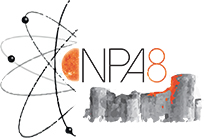Speaker
Dr
György Gyürky
(Institute for Nuclear Research (Atomki)
Description
%
% Nuclear Physics in Astrophysics 8 template for abstract
%
% Format: LaTeX2e.
%
% Rename this file to name.tex, where `name' is the family name
% of the first author, and edit it to produce your abstract.
%
\documentstyle[11pt]{article}
%
% PAGE LAYOUT:
%
\textheight=9.9in
\textwidth=6.3in
\voffset -0.85in
\hoffset -0.35in
\topmargin 0.305in
\oddsidemargin +0.35in
\evensidemargin -0.35in
%\renewcommand{\rmdefault}{ptm} % to use Times font
\long\def\TITLE#1{{\Large{\bf#1}}}\long\def\AUTHORS#1{ #1\\[3mm]}
\long\def\AFFILIATION#1#2{$^{#1}\,$ #2\\}
\begin{document}
{\small \it Nuclear Physics in Astrophysics 8, NPA8: 18-23 June 2017, Catania, Italy}
\vspace{12pt}
\thispagestyle{empty}
\begin{center}
%%%
%%% Title goes here.
%%%
\TITLE{Cross section measurement of $^{14}$N(p,$\gamma$)$^{15}$O using the activation method}\\[3mm]
%%%
%%% Authors and affiliations are next. The presenter should be
%%% underlined as shown below.
%%%
\AUTHORS{Gy. Gy\"urky$^{1}$, T. Sz\"ucs$^1$, Z. Hal\'asz$^1$, G.G. Kiss$^1$, Zs. F\"ul\"op$^1$, L. Wagner$^2$, D. Bemmerer$^2$}
%%%
{\small \it
\AFFILIATION{1}{Institute for Nuclear Research (MTA Atomki), P.O.Box 51, H-4001 Debrecen, Hungary}
\AFFILIATION{2}{Helmholtz-Zentrum Dresden-Rossendorf, Bautzner Landstr 400, 01328 Dresden, Germany}
}
%%%
\vspace{12pt} % Do not modify
% Enter contact e-mail address here.
\centerline{Contact email: {\it gyurky@atomki.mta.hu}}
\vspace{18pt} % Do not modify
\end{center}
The radiative proton capture on $^{14}$N is the slowest, and thus the key reaction of the CNO cycle of stellar hydrogen burning. The rate of the $^{14}$N(p,$\gamma$)$^{15}$O reaction determines the efficiency of the CNO cycle and plays therefore an important role in the understanding of various astrophysical phenomena. The energy generation of massive stars, the solar composition problem and the age determination of globular clusters -- just to mention a few -- are all intimately related to the $^{14}$N(p,$\gamma$)$^{15}$O reaction [1,2].
Despite the huge experimental effort devoted to the cross section measurement of $^{14}$N(p,$\gamma$)$^{15}$O in the latest several decades [3], the precision of measured data is still not sufficient for the astrophysical models [4]. The aim of the present work is to measure the $^{14}$N(p,$\gamma$)$^{15}$O cross section in a wide energy using the activation method which was never used in the case of this reaction. The activation method provides directly the astrophysically important total cross section and the method is free from some uncertainties encountered in the conventional in-beam $\gamma$-spectroscopy experiments. The measurements are carried out at the new Tandetron accelerator of Atomki. Our experiment will provide an independent and precise dataset for this key reaction of nuclear astrophysics.
In the talk details of the experiments and some preliminary results will be presented and compared with literature data.
\bigskip
{\small
\noindent
[1] F. L. Villante, Nucl. Part. Phys. Proc. \textbf{265-2ֲ66}, 132 (2015).
\noindent
[2] M. Wiescher \textit{et al.}, Annu. Rev. Nucl. Part. Sci. \textbf{60}, 381 (2010).
\noindent
[3] Q. Li et al., Phys. Rev. C \textbf{93}, 055806 (2016) and references therein.
\noindent
[4] E.G. Adelberger \textit{et al.}, Rev. Mod. Phys. \textbf{83}, 195 (2011).
}
%%%
%%% End of abstract.
%%%
\end{document}
Author
Dr
György Gyürky
(Institute for Nuclear Research (Atomki)

